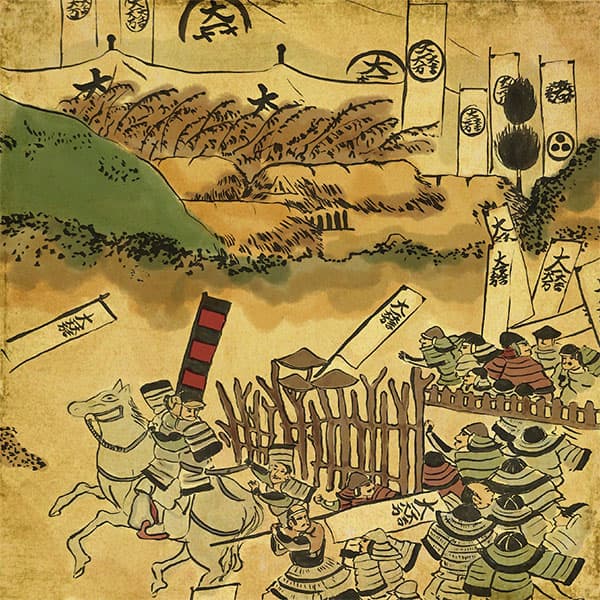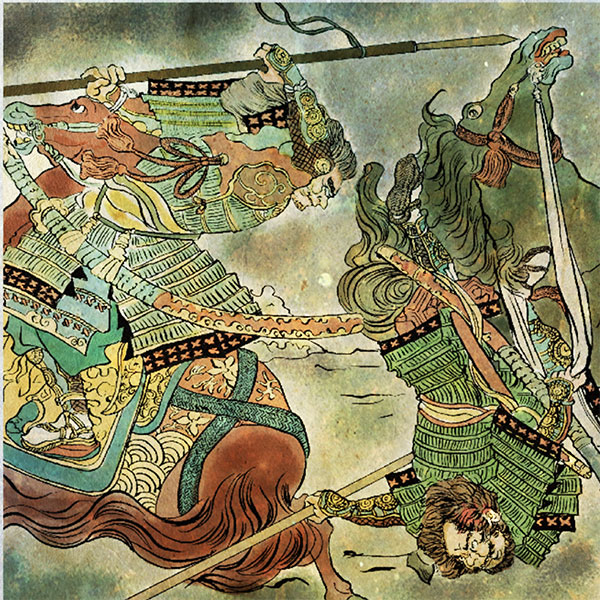Yoshihisa Shimazu (1/2)Commander-in-chief of the three states

Yoshihisa Shimazu
- Article category
- biography
- name
- Yoshihisa Shimazu (1533-1611)
- place of birth
- Kagoshima prefecture
- Related castles, temples and shrines

Kagoshima Castle

Kokubu Castle
- related incident
During the Sengoku period, wars broke out in various places, mainly in the Kinki region where the capital was located. Meanwhile, someone emerges who has won the war and taken control of the region. These include the Hojo family in Kanto, the Mori family in China, the Date family in Tohoku, and the Chosokabe family in Shikoku. Similarly, in Kyushu, there was a daimyo who was on the verge of unifying the region. This is the Shimazu family. Yoshihisa Shimazu united around the four Shimazu brothers, rose from Satsuma Province, and attempted to unify Kyushu. This time we will be looking at Yoshihisa Shimazu, one of the four Shimazu brothers.
Shimazu family of Satsuma
The Shimazu clan began in the late Heian period as a government official who managed the Shimazusho (Japan's largest manor located in present-day Miyazaki and Kagoshima prefectures), which was owned by the Konoe family, one of the Fujiwara five regents. Masu.
Just before the establishment of the Kamakura Shogunate, Minamoto no Yoritomo appointed him as the head of the three provinces of Satsuma Province (present-day western Kagoshima Prefecture), Osumi Province (present-day eastern Kagoshima Prefecture), and Hyuga Province (present-day Miyazaki Prefecture); He officially took on the surname Shimazu and was appointed to the position of guardian.
As a side note, the Shimazu clan has existed since the establishment of the Kamakura Shogunate, when the samurai began to rule, and is probably the only daimyo or clan that continued to rule one place until the end of the samurai era in the Meiji period. The Satake clan also existed from the Kamakura period to the Meiji period, but the country changed from Hitachi Province to Dewa Province in the early Edo period.)
After the establishment of the Shimazu family, feuds and civil wars continued within the Shimazu family throughout the Kamakura period and the Nanbokucho period. Then, in the late Muromachi period, the Italian writer Tadayoshi Shimazu and his son Takahisa emerged from the Shimazu family and unified the Shimazu family. Under these circumstances, Takahisa Shimazu's eldest son, Yoshihisa Shimazu, was born.
Yoshihisa's childhood and the unification of the three states (Kagoshima and Miyazaki prefectures)
Yoshihisa Shimazu was born in Isaku Castle in 1533 as the eldest son of Takahisa Shimazu. His childhood name was Kojumaru.
Yoshihisa had a quiet personality as a child, but his grandfather Tadayoshi Shimazu, the founder of the Shimazu family, saw through Yoshihisa's ability to bring people together and had high hopes for him.
On his New Year's Eve, Yoshihisa took the name Matasaburo, the same as his grandfather Tadayoshi's first name, and after receiving the ``Yoshi'' character from the Shogun Yoshiteru Ashikaga, he changed the name to ``Yoshitatsu'' and later to ``Yoshihisa'' (hereinafter referred to as ``Yoshihisa''). .
In 1554, he participated in the battle against the Kokujinshu in Satsuma and Osumi provinces and made his first battle. In 1566, when his father Takahisa retired, he became the 16th head of the Shimazu family. Until the first year of Genki (1570), he was engaged in the unification of the Kokujinshu of Satsuma Province, and in the fourth year of Genki (1573), he brought the Kokujinshu of Osumi Province under its control and unified Osumi Province. At the age of 40, Yoshihisa Shimazu brought together the chaotic states of Satsuma and Osumi.
This story takes place before the first year of Genki (1570), when the Shimazu family subdued Satsuma Province. The Shimazu family was in conflict with the Ito family of Hyuga Province over ownership of Shinkoin, which borders Satsuma Province, Osumi Province, Hyuga Province, and Hizen Province (present-day Kumamoto Prefecture).
In 1572, the Ito family invaded Shimazu family territory with an army of 3,000, and the Shimazu family attacked with 300 troops led by Yoshihisa's younger brother, Yoshihiro Shimazu, as their general. Yoshihiro Shimazu attacked with tactics such as ambush, destroyed the Ito clan, and drove them back (Battle of Kizakihara).
In 1576, the Ito family was severely defeated by the Shimazu family, and one after another, their vassals defected and joined the Shimazu family. Yoshisuke Ito, the head of the family, fled to the northern neighbor of Hyuga province, relying on Sorin Otomo of Bungo Province. . Here, Yoshihisa Shimazu unified the three states of Satsuma, Osumi, and Hyuga.
The Battle of Mimikawa and the influence of southern Kyushu
Yoshisuke Ito of Hyuga Province fled to Sorin Otomo.
In 1578, Otomo Sorin, who protected Ito Yoshisuke, invaded Hyuga Province. Sorin himself remained in Mashiga (present-day Nobeoka City) in the northern part of Hyuga Province, and sent 43,000 soldiers south, with Tahara Shōnin as the commander-in-chief.
In contrast, the Shimazu family, which had annexed Hyuga Province, had 3,000 soldiers, led by their youngest brother Iehisa Shimazu, holed up in Takajo (currently a castle in Kijō-cho, Koyu-gun, Miyazaki Prefecture). The Shimazu family, holed up in their castle, and the Otomo family, surrounding Takajo, continue their battle of ups and downs. Yoshihisa Shimazu led 20,000 soldiers from Satsuma and Osumi provinces, launched a surprise attack, and defeated the Otomo family. The major military commanders of the Otomo family were defeated one after another and retreated. The Shimazu family protected Hyuga country from the Otomo family, but that was not all.
Seeing the progress of this battle, the Kokujinshu of Higo Province (present-day Kumamoto Prefecture), where the Otomo family served as guardians, switched sides to the Shimazu family. In 1581, the Sagara clan in the Kuma region surrendered, leaving most of Higo Province under their influence. Yoshihisa Shimazu steadily brought southern Kyushu under his control.
By the way, this story happened a while before they started to exert influence in Higo Province.
In 1580, the Shimazu family made peace with the Otomo family. This peace involved the Oda family, which continued to expand its hegemony mainly in the Kinai region.
Oda Nobunaga, who unified the Kinki region, was planning to attack the Mori clan in the Chugoku region. Therefore, he had the Mori family attack the Otomo family in northern Kyushu, trying to pincer the Mori family from the east and west. However, the Otomo family was in the midst of a conflict with the Shimazu family. So Oda Nobunaga had a discussion with Yoshihisa Shimazu, and Yoshihisa recognized the Oda family's supremacy, and Nobunaga agreed to recognize the Shimazu family's territory. The Shimazu family entered into a peace agreement with the Otomo family. However, the Shimazu family continued to invade various places.
Battle of Okinawate and unification of Kyushu
After the Otomo family declined due to the Battle of Mimikawa, the Ryuzoji family of Hizen Province (present-day Saga Prefecture, Nagasaki Prefecture) began to grow in power. The Arima family, whose territory centered on the Shimabara Peninsula, was under pressure from the Ryuzoji family and asked the Shimazu family for help.
Thus, in 1584, Shimazu Yoshihisa, with his younger brother Iehisa as the commander-in-chief, fought with over 5,000 soldiers against the 25,000-strong Ryuzoji clan in the Battle of Okitanawate. In this battle, the head of the Ryuzoji family, Takanobu Ryuzoji, and other clans and powerful retainers were defeated, and the Ryuzoji family surrendered to the Shimazu family.
The only person left in Kyushu was Sorin Otomo, who remained in his main territory, Bungo Province. Yoshihisa Shimazu's conquest of Kyushu was just around the corner. Oda Nobunaga, who had come to terms with the Otomo family, committed suicide at Honno-ji Temple two years ago. Harmony is essentially back to square one. The Shimazu family decided to attack the Otomo family.
Otomo Sourin, now a light in the wind, asked Toyotomi Hideyoshi, who was newly becoming a ruler of Japan, for reinforcements.
Yoshihisa surrenders to Toyotomi Hideyoshi
In 1585, in response to a request for support, Hideyoshi dispatched the vanguard of the Toyotomi family, centered on the Chosokabe family of Shikoku, to Kyushu. However, the Shimazu family intercepted them (the Battle of Totsugawa) and drove them back.
Therefore, in 1587, when the main army of the Toyotomi family, who assembled an army from all over Japan, invaded, the Shimazu family withdrew, and the Kokujinshu from all over Kyushu descended to the Toyotomi family.
Yoshihisa shaved his head and descended to Hideyoshi, and the Shimazu family became vassals of the Toyotomi family.
- related incident

- WriterTomoyo Hazuki(Writer)I have loved history and geography since my student days, and have enjoyed visiting historical sites, temples and shrines, and researching ancient documents. He is especially strong in medieval Japanese history and European history in world history, and has read a wide range of things, including primary sources and historical entertainment novels. There are so many favorite military commanders and castles that I can't name them, but I especially like Hisashi Matsunaga and Mitsuhide Akechi, and when it comes to castles, I like Hikone Castle and Fushimi Castle. Once you start talking about the lives of warlords and the history of castles, there's a side of you that can't stop talking about them.







